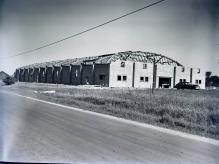

Bowen's Roller Rink, now Funspot, is located just southeast of the intersection of 52nd and Division Avenue, at 14 52nd. A Saturday afternoon in the winter was a good time to take the Division Avenue bus to Bowen's for an afternoon of skating. The rink was being built in May of 1948, shown below.
Left click on the image below for a larger version.
It was built by the grandparents of Don Bowen, class of 1953, and one of at least two rinks, a second one being on the north end of town.
From the outside the building was a large rectangle, with a slightly arched roof. The style is characteristic of sports buildings of the 1940s and 1950s, when functionality and low cost were of primary interest. Entering, the structure was two story in the front, followed by the large wooden floor skating area. To the right as one entered the skating area was a place to rent shoes, and in the back, on the left, was a large furnace which emitted a large blast of warm air that made the place a delight on a cold winter day.
At the front end there was concession area on the second floor. To get to it one had to "walk" up a set of stairs, which most people did with with their skates on. Coming back down was a thrill all by itself. One has to believe that those were simpler times - today's insurance restrictions and lawsuits would make an informal operation like Bowen's essentially impossible.
To the right of the stairs going to the concession stand there was a small apartment. Just what the reason for it was is unclear, but it was used by Don Bowen, class of 1953, and his wife, for a while, according to Lee Smith, class of 1953. In fact, the two were married on skates...
It was common in the early 1950's for Godwin to rent Bowen's for several hours after school for some special occasion. All of the fifth graders from North, South, West, and the Division Avenue grade school might meet at Bowen's after school for example, and a Division Avenue Bus Line bus or two would be rented for the occasion to get everyone there and back to the school later.
|
|
|
|
|
|
|
|
|
||||
|
|
|
|
|
Material provided by Ron Torngren, Godwin class of 1953, and Bob Traetz and Sharon (Pitcher) Hawkins, Godwin class of 1962.

Buchanan woods, as it was known to people in the 1930's and 1940's, occupied the area between Buchanan Street and the Grand Rapids and Indiana railroad tracks, and 34th Street and 32nd Street. An 1876 Wyoming Township map shows the property was owned by Cyrus Jones. The woods was old enough to have a large number of old, dead trees, and supported a great deal of flora and fauna, including many species of woodpecker, which need decaying trees.
A stream originating from a large swamp area on the south side of 36th Street, and mostly to the east side of the Grand Rapids and Indiana railroad tracks passed along the east side of tracks, and eventually through Buchanan woods. Many have said that this was a trout stream as late as the early 1930's, as was Plaster Creek. GM started polluting the stream after about 1936. The stream still flows, but there has surely not been a trout in it for over 65 years, nor could one survive today. ( Paris township developed faster than it could process its sewage, and started dumping raw sewage into Plaster Creek in about 1938. Because of over development, Plaster Creek is now little more than a large drainage ditch. ) Eventually it flows into Plaster Creek, and the entire polluted mess eventually empties into the Grand River.
Sometime in the late 1940's Buchanan woods was sold to developers. A Housing tract consisting of the west side of Buchanan, Birchwood, and Hillcroft streets was completed by late 1950. North of 34th Street the stream was Reinald along the railroad tracks, and the original stream bed filled in with stumps and other forest debris. The remaining woods was largely cleared for a park. Alas, many of the trees left standing were majestic elms, and once Dutch elm disease reached Kent County the park became a largely barren piece of land. The entire stretch of land behind Hillcroft Street, and between 36th and 32nd Streets, is now all part of a sports field used by the Godwin School system. Current maps of the area show that the park is now called Hillcroft Park.
( Material provided by Lewis Lull, class of 1940. )


( Photograph provided by Lewis Lull, class of 1940, scanned and sent by Craig Lull, class of 1970.)
Left click on the image below for a larger version.
The bell from the Godwin one room schoolhouse. The purchase price was $100, which was an incredible amount of money in 1867. Budgeting allowed for two rope changes a year, as weather and use wore them out. It now sits in the display case located in the lobby of the new highschool building, part of a display paid for by the class of 1981. The bell was stored in the basement of the old highschool building for much of the period from 1924 to 1981.
Bells like this one were sold in different sizes by Sears & Roebuck in the late 1800s, for example. The 1908 catalog still contains school bells. The one shown about has a number 6 on it, having to do with its size. Bigger bells, for bigger schools, would have had a lower pitch, and more range to summon students from a wider area.
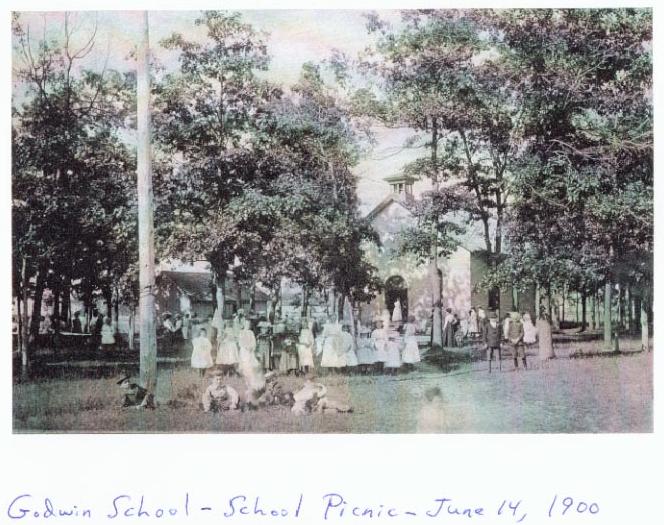
( Photograph provided by Lewis Lull, class of 1940, scanned and sent by Craig Lull, class of 1970.)
Godwin school as it existed in 1900. The main building (built in 1867, and demolished around 1925) is said to have stood where the library (built in 1937) now stands. ( Other accounts say it was demolished to make room for the south addition to the new school on Division Avenue. ) The bell was kept, and stored for years in the basement of the highschool building on 36th Street. It is now on displace in the new highschool. What was the smaller building to the left of the classroom used for? Facilities? It appears that the area behind the school is open space - perhaps a field. The bare wooden pole was perhaps a flag pole?
The "History and Directory of Kent County, 1870," section on Paris Township describes the schoolhouse as follows: "There are several fine school-houses in the township. The Godwin school-house standing on the old plank road, a short distance beyond the Godwin tavern, is a good brick building, and an ornament to the locality. The school-house on the southwest corner of the section 10, built of brick, presents a fine appearance, and exhibits the enterprising character of the inhabitants of the vicinity." Just how close to the northeast corner of 36th ( formerly Allen Road ) and Division Avenue (formerly "the old plank road?" ) remains unknown for now. Note the reference to Godwin Tavern. It is not known just now where the tavern and inn stood, but apparently it once was a way station for people making the journey to and from Kalamazoo over what is now Division Avenue. Literally covered by wood planks, to control the mud and dust, the 50 or so miles between Kalamazoo and Grand Rapids must have been a punishing journey in the 1850s, and the Godwin Tavern a welcome relief. Hopefully a photograph exists yet somewhere. The tavern was built in 1865, and burned in 1871. Said to be an upscale social center as well as an inn, it's perhaps surprising that it was not rebuilt, but then the Grand Rapids and Indiana railroad, also going between Grand Rapids and Kalamazoo, was completed in 1870, and it's likely that Division Avenue saw much less long distance traffic after that. Similar to what happened after the US-131 freeway was built in the 1950s, when many businesses catering to travelers found themselves bypassed, and and went out of business, this perhaps happened yet again after 1870 when people started to take trains rather than stage coaches.
Apparently there was no 36th Street (formerly Allen Road) as of 1900. Does anyone know when the road was put in, and why? One can see something of a dirt path, just to the right of center of the bottom edge of the photograph, which seems to head to the entrance of the school. Where would the path be coming from? Does anyone else see the partial image of a person near the start of the path? Perhaps someone standing too near the camera to be in focus?
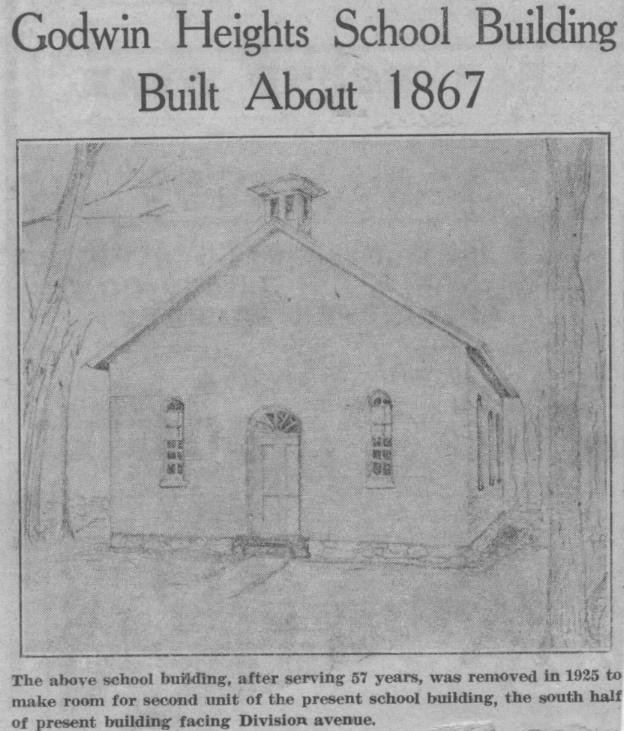
Drawing supplied by Lillian Annis, class of 1941.
The item above suggests that the one room school house was demolished in 1925, to make room for the south addition to the school on the east side of Division Avenue. Charles Saur pointed out that the one room school house was still in decent condition when it was demolish, 57 years after it was built.
One thing the drawing adds that is not shown in the photograph below, because of the students standing in front of the school, is that the building had the kind of primitive foundation typical of smaller buildings built in the mid 1800s. Likely built of stones held together by low quality cement, the foundation of homes and buildings still surviving from the time often have to be replaced. But Charles Saur says the school was in good condition in the 1920s yet.

Left click on any image for a much larger version.
Material loaned for scanning by Polly Goeman, class of 1959.
Martin H. Goeman, who is on the right side of the first row in the images about, made this photograph possible. He loaned it to the now defunct Photo Reporter as well as supplying what information is known about it. It is likely that the photograph was taken outside the front door of the school. One can easily see the brick construction that is not so obvious in many photos taken from a greater distance. Perhaps the school was whitewashed once, given it that white appearance in many photographs.
In 1922 Godwin was still a 10 year school, meaning those who wanted to finish highschool had to go in to Grand Rapids to finish up. But many did not. It was common for people to drop out of school in the 8th grade or before. A lot of work was unskilled, or barely so, and not many planned on going on to college. But Godwin became a 12 year school in 1927, so most of the kids in the photograph would have been able to graduate from Godwin if they choose too. After that, many Godwin graduates come from surrounding one room school houses, often from 8th grade, to Godwin to finish. The schools included Smith school, in Dutton - on 68th Street, a few miles east of Kalamazoo. It too ingenuity for students to get to Godwin each day for classes.
The photograph shows more than one grade. Vivadale Harding, number 1, graduated in 1932. Norma Van Allen, number 3, graduated in 1936. Fred Bartels, number 4, graduated in 1934. None of the other names show up in any of the annuals or other lists of graduates. Only a little over a third of those in the photo have been identified, and it's quite likely none of the rest ever will be known. The kids are too young to compare to graduation photographs.
Sadly, every kid in the photograph likely received a photograph like this, and yet so few survive. And there must have been many such photographs taken over the years. But so far this is the only one to surface, and shows the foresight of Martin Goeman that even the 13 names (including the teacher) still survive. In another two or three years the one room school house would disappear. At present it's not even known exactly where it was located. It should be a priority now to establish this while there are still living alumni who remember the building.
The fate of Margaret Long is not known. She could well have continued to be a teacher at Godwin for years - she does not look all that old in the photograph. But school records from the 1920s are almost non existent now. The 1929 annual shows 10 teachers, but she is not among them.
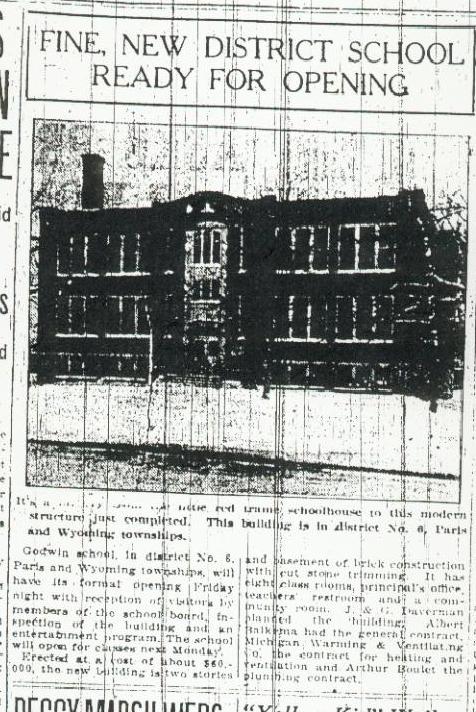
( Material provided by Lewis Lull, class of 1940, scanned and sent by Craig Lull, class of 1970.)
The eight room school that replaced the one room brick school that was Godwin from about 1867 to 1923. The photo dates from about December, 1923. Later there were additions to the north and south ends - classrooms and an auditorium on the south end, and classrooms and a gym on the north end, all completed by about 1927 according to a cornerstone on the building.
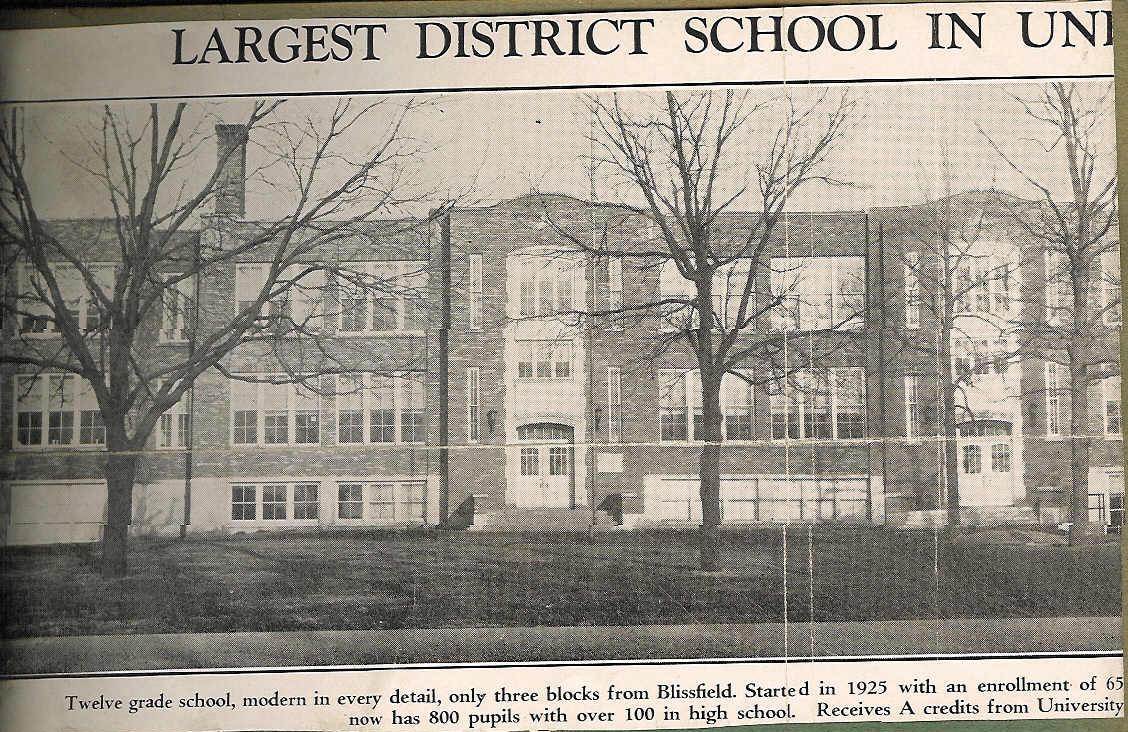
( Material provided by Lee (Tanner) Collins, class of 1941. )
The school as it appeared after the north and south additions were completed. It was serve all grades, K-12, until 1929, when the first section of the highschool building was completed, eventually becoming the grade school building.
Left click on the image below for a larger version.
The postcard was made available for scanning by LeRoy Rockwell, class of 1959.
A postcard image of the Division Avenue school, provided by LeRoy Rockwell, class of 1959. Postcards of just about every building, street, and person, were taken in the early part of the 1900s, when cameras were not common. Today, where they still exist they usually have significant historical value, are eagerly collected, and can be quite valuable.
A guess as to the date the photo was taken would be some time after 1927, since both the north and south wings of the Division Avenue building are complete.
Left click on the image below for a larger version.
Click here for a very large version of the photograph.
The photograph was made available for scanning by Dave Van Dyke. His father
worked for a number of years at Godwin, some time in the 1920s through the
1950s.
The photograph above, taken in 1924, is interesting for a few reasons. In the upper left corner of the group photograph is shown Charles Saur and Gladys Gaut. Charles Saur says he was recruited by Frank Rackett in August, 1924, and hired by him in September. So the photograph above had to have been taken between September and December, 1924. Given the dress of the students, it seems unlikely that it was taken much past early October.
The school building itself, the center section of the school on Division Avenue, had just recently been completed. The stone to the right of the doors says "erected 1924." One can see along the bottom edge of the photograph, and at the right side, under the window, that there is no grass, and no sidewalk had put in yet, no doubt much to the delight of the custodians. And it is quite possible that the one room school house, built in 1867, is still standing off to the right of the building shown above. Exactly when it was torn down is not known at this time.
The caption on the frame of the photograph is "Godwin school 8th grade class 1924." What is curious about this is that all of the people in the photograph would have been members of the graduating class of 1928. There were only 12 people in the graduating class of 1928. So either a large number of people moved, or otherwise dropped out before graduating, or the caption is not quite right. And it is possible that some students moved in to the Godwin area between 1924 and 1928, so that not all of the people in the 1928 graduation photograph are in the one above. The area around Godwin was growing rapidly at the time. It's also possible the photograph actually shows a couple of classes.
As is all too often the case, there is no indication on the photograph who the people in it are. Some might be identified by looking at the graduation photos for 1927 to 1931. It is possible that the person to the right of Gladys Gaut in the photograph is Morey Galloway, class of 1928. But other than Charles Saur and Gladys Gaut, for now it is unknown who the people in the photograph are. If all are 8th graders, every person in the photograph would be a minimum of 96 years old in year 2007, meaning that it is not likely that anyone is alive to provide additional information. Too, people's looks can change a lot between the 8th and 12th grades, making identification even more challenging.
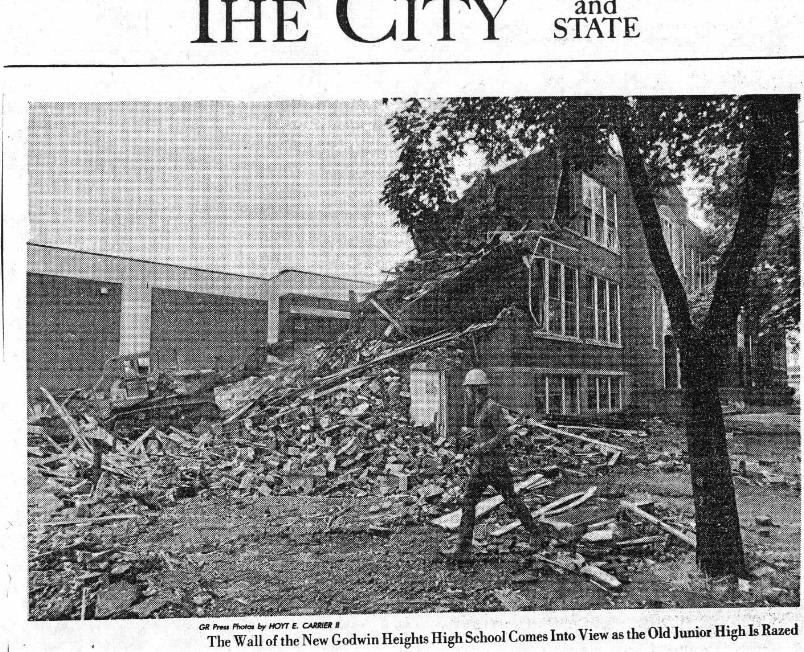
( Material provided by Lee (Tanner) Collins, class of 1941. )
The building went down in June or July, 1974.
What was, as of 1927, the Godwin school system, makes way for the proverbial parking lot. The GR Press photo is undated.

( Material provided by Lee (Tanner) Collins, class of 1941. )
A time capsule was found when the old junior high is razed. While it doesn't appear that anything of any great significance was found, where would the material be today?
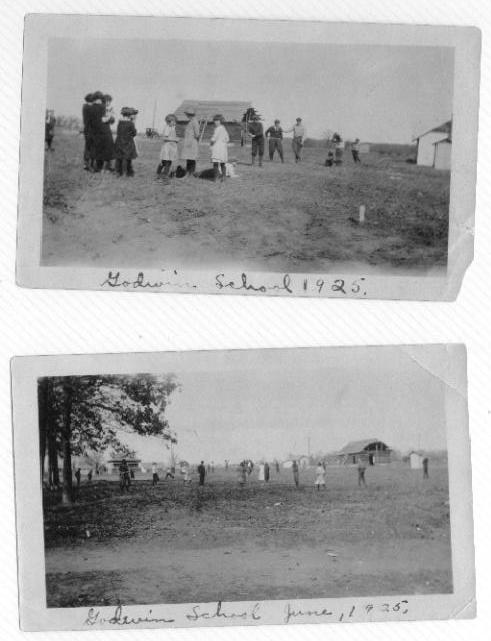
( Material provided by Lewis Lull, class of 1940, scanned and sent by Craig Lull, class of 1970.)
It's not clear just where these photos were taken in relation to the new (as of 1924) school building, but do seem to indicate that the area surrounding Godwin was still fields, or perhaps farmland, in some places. The bottom photograph seems to show that the one room brick schoolhouse, built around 1867, has been razed. There seems to be a depression in the ground just below where the people are standing that is about at the location where the school was. It was torn down some time after the new school building was completed. Perhaps right after.
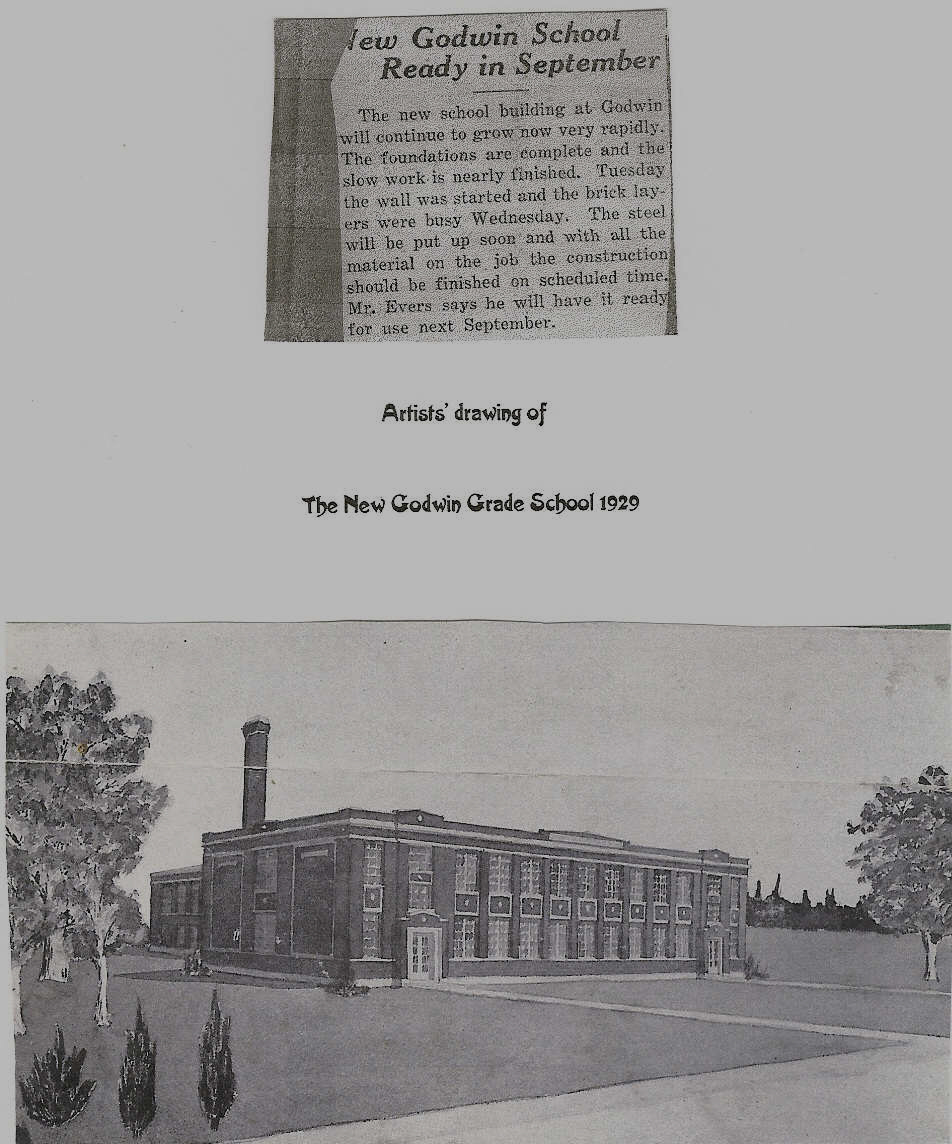
( Photograph provided by Lee Collins (Tanner), class of 1941. )
Artist's drawing of the new highschool, to be completed in 1929.

Note the piece above showing the cornerstone box in the Division Avenue building being investigated. Given the strength of construction of the old highschool building, it's hard to imagine it being torn down. But then one might have said the same thing about the library building.

If there was any doubt before, the piece above makes it clear that the 1929 Acorn was the first annual. Whether the classes of 1927 and 1928 produced scrapbooks, or something else, on their own, is not known. The class of 1943 also had no annual, but most students did use a scrapbook as a substitute.
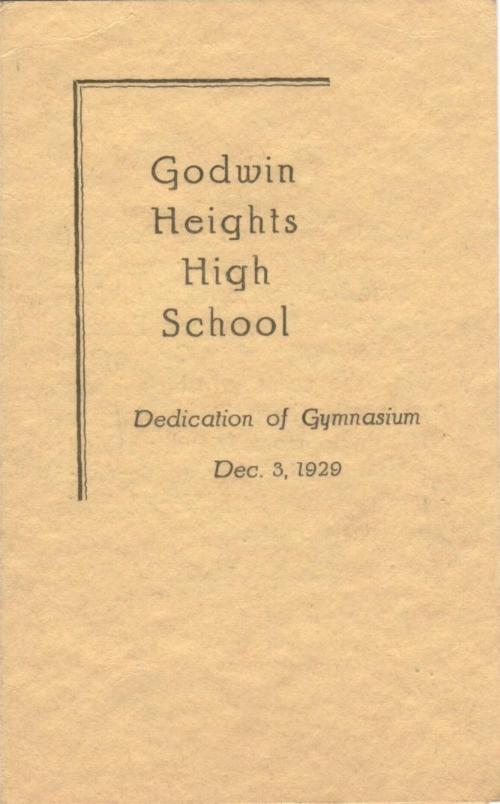
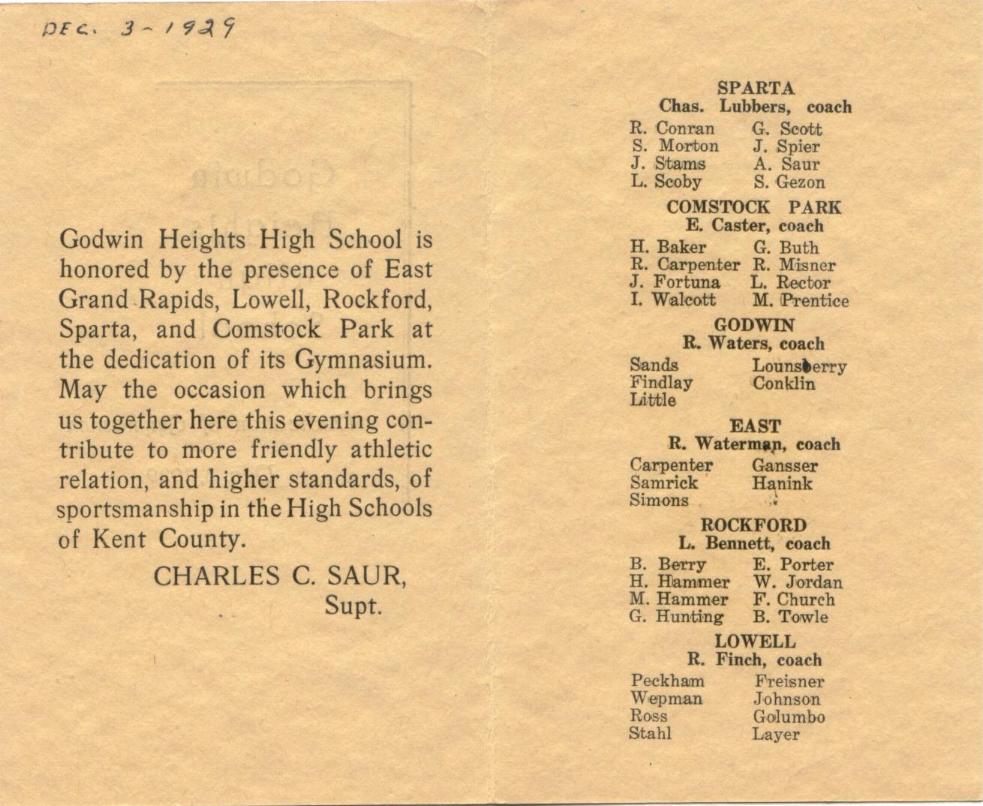
Material provided by Lee Collins (Tanner), class of 1941.
1929 program notice for the dedication of the new gym behind the highschool building.
|
High School - from 1938 annual. |
Library - from 1938 annual. |
( Photographs provided by Kim (Shepard) Brown, class of 1970.)
Left click on the image below for a larger version.
The highschool building in 1956, in a view that was familiar to many Godwin students for several decades.
( Photographs provided by Kim (Shepard) Brown, class of 1970.)
An undated photograph, but probably around 1960 based on other photographs it was with, of the highschool building in the summer. The activities going on inside at this time might be finishing us report cards, preparing documentation for the next school year, and starting the big cleanup job to get the building ready for fall. Everyone remembers those nicely waxed floors that one found the first day of the new school year, as one picked up their schedules, and wore some of their stylish new school duds for the first time.
The two doorways on 36th Street in the highschool building each led to a hallway to the main hallway. On the other side was a door, which was always locked. No one ever questioned what was behind the door, or perhaps just assumed there was a storage closet. In fact, the original section of the highschool building had basements on the east and west ends, and a utility crawl space in between. Consistent with the very substantial construction of the original section of the highschool building, the walls are thick, and while poured in 1929, they look like they could have been poured within the last five years.
The west end basement also houses a gigantic vacuum cleaner, which powers the central system used to clean carpets all through the school today. Better than the old, easy to maintain tile and terrazzo floors?
Left click on any image below for much larger versions.
|
|
|
|

Originally the airport was bounded by 32nd and 36th Streets, Jefferson Avenue, and the NY Central railroad tracks. One runway pretty much put planes right over Godwin. Likely little more than a minor nuisance, in year 2005 it is unlikely that the airport and the surrounding community could peacefully coexist.
The photograph above is undated. The DC-3 started service in 1935, and the library building was built in 1937. A guess is that the photograph was taken either from the second floor, or the roof, of the highschool building which would place it around 1938. The West wing of the highschool was built as a W.P.A. project in 1938.
( Photograph provided by Lee Collins (Tanner), class of 1941. )
The tunnel under Division Avenue was completed in about 1933, and is shown below - the text is sightly blurred because of an inability to flatten the source on the scanner.
Left click on the images for a larger version.
Left click on the image below for a larger version.

LeRoy Rockwell, class of 1959, supplied the material for scanning.
From the December 15, 1933, issue of "The Godwin High News," apparently it was not easy to get Godwin students to use the new tunnel. This gave way to the formation of "safeties," who could in principle make students use the tunnels.

An undated photograph, it appears that a northern extension of the east wing of the highschool is under construction and this was completed by 1941. The Quonset building was in place by 1946. From this, and the vintage of the cars in the photo, a guess is that the photo was taken between 1941 and 1946. Wexford Street was not built up, and the old airport, once farm land, and later part of the Kent county fair grounds, can be seen in the back. Riding bicycles in the winter, the students of the time were clearly a hardy lot.
( Material provided by Lee Collins (Tanner), class of 1941.)
Left click on the image below for a larger version.
The photo above of the Godwin area was taken about 1940.
Left click on the image below for a larger version.
The caption states that the brick facade on the 36th Street side of the school was only being replaced in 1941. Curious. Why would that be?
The image shows a little more of the surrounding area, but only with newspaper image "quality."
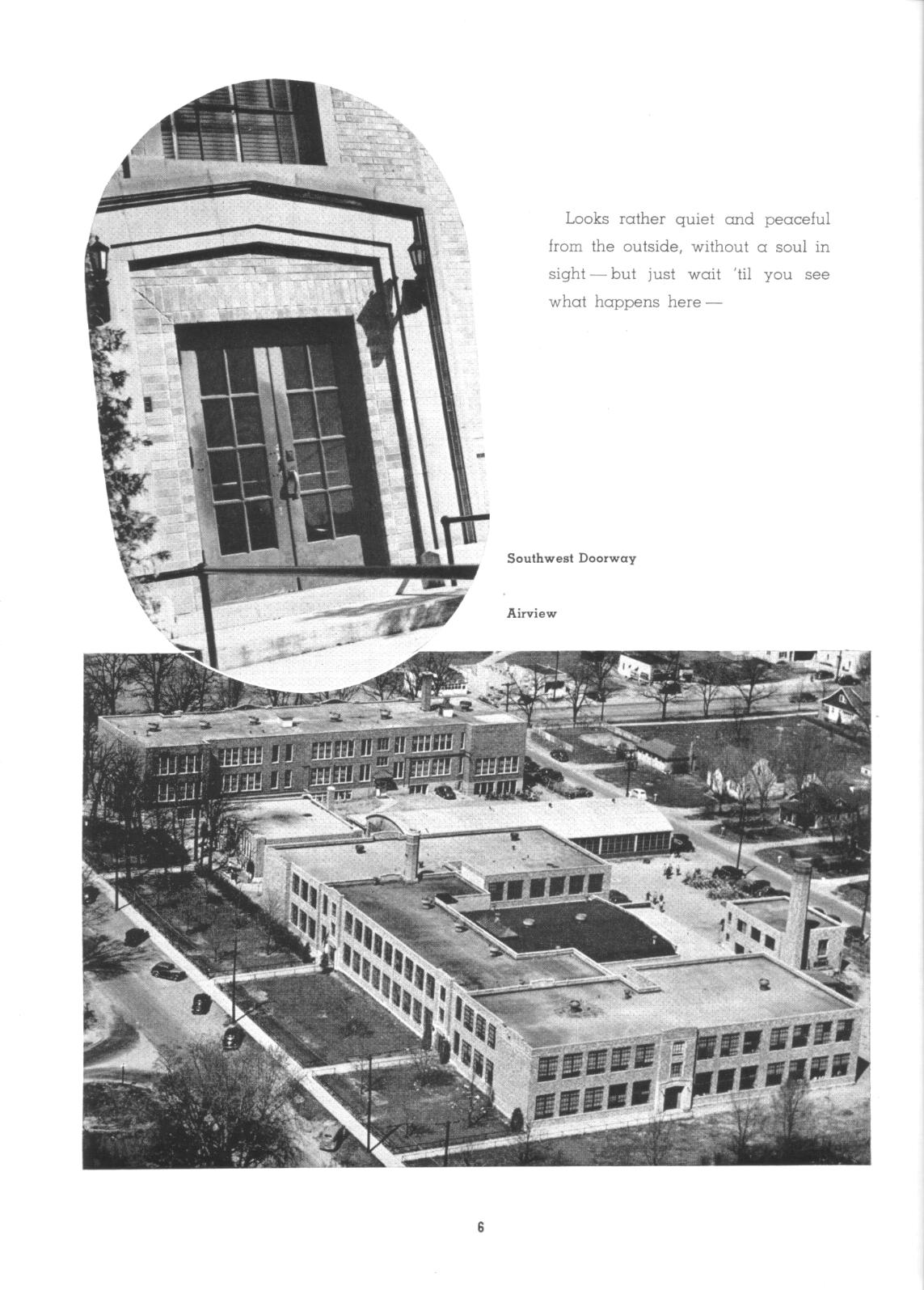
1946 aerial photo of the Godwin system, from the 1946 class annual. Left to right Elementary, Library (office and museum) and highschool. The Quonset hut ( named for Quonset Point, RI, where they were first made) was the shop building, and obtained from the National Youth Administration when that program was discontinued. The small building was a utility building, and contained boilers for heat.
Notice that 36th Street and Wexford are still dirt roads in 1946. The custodians must have been thrilled with that.
Left click on the image for a much larger version.
Photograph supplied by Bob McDonald, class of 1943.
An undated aerial view of the old airport and the surrounding area. The streaks on the image were on the original. Sadly, it is a summer shot, so trees hide a lot of interest details.
One can see Godwin on the right side, about one third of the way up from the bottom. In the lower right corner, one can see the Walbridge farm and trailer park, and slightly below and left of it the Beehive restaurant. The trailer park was removed in 1955 or abouts, so the photograph has to be from at least 1955, but after 1946, since the shop building can be seen in the photograph too.
In the upper left one see the still active NY Central railroad tracks. When built in 1870 it was the Grand River Valley railroad, and was promptly leased to the Michigan Central railroad for 999 years. At some point it was sold to the NY Central railroad, having caught the eye of the Vanderbilt's. It was last part of the CSX system, and is now abandoned southeast of 44th Street and Kalamazoo, and totally abandoned in a practical sense. It was last used by Steelcase and the Heckman Biscuit Company to move supplies in and out, but neither uses the rail today, Steelcase being all but out of business, and Heckman now uses trucks.
One sees nothing of Steel case in the upper left portion of the photograph, and most of Eastern Avenue, running to the upper right part of the photo, is still farmland on the east (top) side of the road. This again would suggest the photograph is from the early 1950s.
Just to the left of Wexford, on the north side of Godwin, one sees the runway that brought a lot of planes over Godwin over the years. See the example on this page, above, which shows a DC-3 coming in for a landing. Today of course no airline would dare fly anywhere near a school, but 50 years ago it was a more practical world in many ways.
On the left side of the photo, about one third of the way up, there appears to be a plaza north (left) of the terminal building.
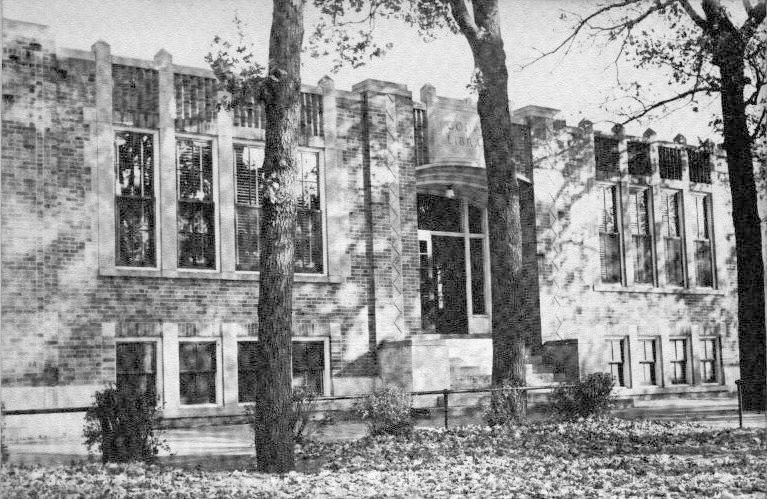
Photograph provided by Ron Torngren, class of 1953.
The oak trees in front of the library are very likely some of those shown above in the 1900 photograph of a school picnic. If so, and if they still exist, that would make them about the oldest original features of the Godwin system.
Left click on the images below for larger versions.
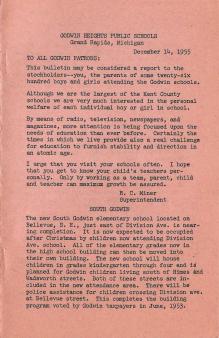
|

|
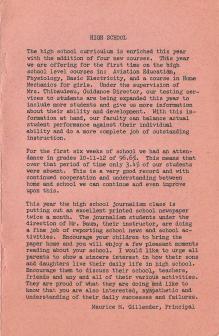
|
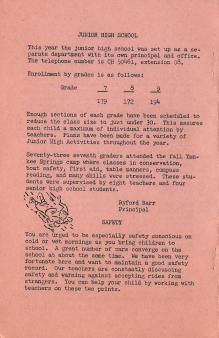
|
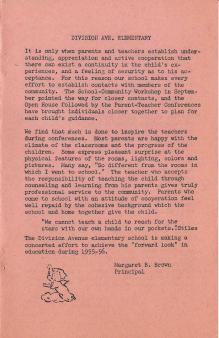
|

|
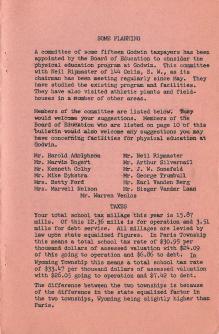
|
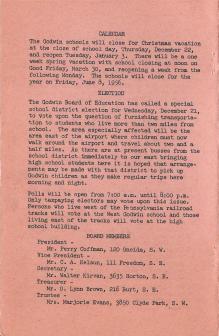
|

|
Left click on the images below for larger versions.
Material provided by LeRoy Rockwell, class of 1959
Left click on the images below for larger versions.
Material provided by LeRoy Rockwell, class of 1959
Photograph taken by Ed Hammerslag on May 21, 1987, and provided by Louise Lull, both of the Godwin class of 1940.
Left click on the image below for a much larger version.
Notice in the 1946 aerial photograph above the Quonset Hut shop building, purchased from the National Youth Administration, moved to the location shown, and ready for use in September, 1944. According to students there at the time, the shop building was torn down some time in 1979.
Left click on the image below for a much larger version.
Material provided by Mildred Annis, class of 1940.
A mural on the hall wall facing 36th street, on the main floor of the highschool, summarizes the history construction of the Godwin infrastructure up to about 1954. Jim Isler, class of 1967, photographed them just as renovation of the building was beginning, and before they were destroyed. The painters were Fred Cook and Larry Esakson. It's not clear when the mural was painted or whether it was painted in sections as new buildings were added. Does anyone know the history of the mural? The last entry is the north addition to the west wing of the highschool, and is dated 1954. Larry Esakson in the class of 1955, and a Fred Cook cook in the class of 1956 were the mural's painters.
|
|
|
The first two images are basically the same. The first shows the name
of one of the painters, Fred Cook, and the second probably has more
accurate color.
One room schoolhouse.
One room schoolhouse - better colors.
The view of the grade school shows the south end addition, made in
perhaps 1927. The original section of the building was completed in 1924.
Grade school, started in 1924.
Visible to the right of the library is the shop building, purchased
in 1946 from a defunct federal government project. The last addition
to the highschool building was in 1954, and included the cafeteria.
It too was built to the same prison construction standards as the rest
of the building, which was almost indestructible.
Library, Quonset hut, highschool additions.
North end addition on the east side of the highschool building.
Another view of the highschool building.
Spanish theme.
( Photographs provided by Jim Isler, class of 1967. )
Material provided by Lee (Tanner) Collins, class of 1941.
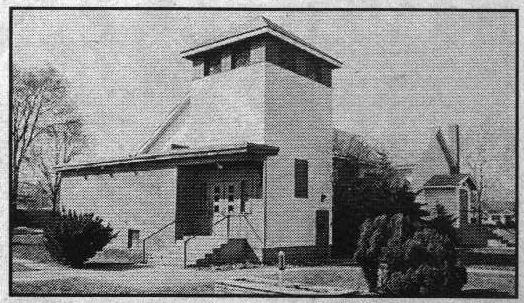
( Photograph provided by Lee (Tanner) Collins, class of 1941. )
According to Kim (Sheppard) Brown, class of 1970, the building above was once the Metropolitan Baptist Temple, and before that a Christian reform church. Apparently kids knew how to gain access to the church and take a dip in the baptismal "pond."
The Wyoming Advance, April 6, 1999, states that the structure was razed a short time after the photograph above was taken. The property, bounded by Wexford, 36th, and Jefferson Avenue, and described as "six lots," might be have been turned into a learning center if politics permitted. As of November, 2001, nothing has been done. ( It is still empty lots in December, 2004. ) As any good developer knows, you tear down a building ASAP so no one can change their mind. In this case the result is an empty lot.

Left click on the image above for a larger version.
Badge made available by Delores Esakson, class of 1962.
Band activities at Godwin date to 1930, and probably earlier, as shown in a 1930 photograph. The name of the band director is unknown here. The orchestra appears to be almost all violins, which must have made it challenging to find appropriate music. According to a 1939 annual page, an orchestra was formally organized in 1938, by Evelyn Barr, and by 1939 was said to be "already playing for most of the school's important activities." What happened through the Great Depression years of 1930 through 1937 or so is not clear. The early annuals mention nothing, and for most of the Great Depression years there were no annuals. A 1941 annual page provides the first photograph of something explicitly called a band, and the director was Albert Smith. Again, whether a band existed earlier, and for whatever reason was not featured in any earlier annual, is unclear for now. By 1942 the band was prominently featured in each regular annual (there is no 1943 class annual ). In about 1942. Albert Smith joined the service. In 1946 he returned to Godwin briefly, and then took a position at Grand Rapids Junior College. Evelyn Barr became the band director in 1942, a position she held until 1955. In 1955 Bob Traetz came to Godwin from a school in Muskegon, and was band director until 1976.
The following material shows some of the highlights of the Godwin band, and highlights the careers of its two longest service directors, Evelyn Barr and Robert T. Traetz. Bob Traetz Jr., class of 1962, has provided much of the material.
For the musically challenged among us, left click on the image above to see how an orchestra is structured. A marching band would not have the string instruments however.
|
|
|
|
Left click on any image above to view the story of each director.
The Mini Majorette
---------------------------------------------

|

|
Patty Saurman, class of 1953, in 1942. Apparently the Shirley Temple of the Godwin band, she was about 7 or 8 at the time.
Godwin has had a long tradition of being flexible, and letting students do what they can do, even if it meant some slightly unorthodox approaches. Apparently one of the regular majorettes fell ill, and somehow Patty was offered the opportunity to fill in. Which she did for the next 3 years or more. Apparently the novelty of the diminutive majorette was popular, and she was a full fledged member of the majorette squad for a while.
See Patty Saurman in 1944, and in 1945,
Left click on the image below for a larger version.
Band Mothers was an important organization in the 1950s and before for supporting Godwin bands. In addition to providing yet another mechanism for community involvement, and a way for the parents of Godwin students to become acquainted, Band Mothers held events and raised money for band equipment and events.
The item above shows that a band uniform cost $62 in 1957. That might be $300 to $400 in 2005. If one adds the cost of an instrument, uniform, travel, and band instructors and directors, it's clear that operating a band is a substantial expense.
It was relatively common for Godwin graduates to join a branch of the service and play in the military band. An example is Ed Livingston, class of 1953, who joined the Army. Unless it was in combat areas, it was probably safer to blow a horn than risk getting blown up.

The Godwin school board early on attracted prominent members of the community to help shape the direction of the evolution of the school. Many members served for a large number of years. Charles Saur provides an account of some of them in a 1941 newspaper piece about the history of Godwin. The piece mentions the years in which various school board members were first elected.
Frank Rackett served from 1908 through 1947, when he left the area to live with a niece in St. Louis, MO. While he did a great deal for Godwin, those who knew him best are now long gone, and for now there are few personal details available about him. At this time it is hard to know just what he did for a living. Some describe him as a professional taxidermist, but Charles Saur says this was a hobby. He did some farming on the 10 acres he owned. Perhaps mostly asparagus, where the tennis courts would come to be, at the northeast corner of 36th Street and Buchanan Avenue. Some say he owned property in the area around Godwin, and collected rent on it. See section "R" for more on Frank Rackett.
It is interesting to note in Charles Saur's piece that people in 1908 were apparently not particularly civic minded, and Frank Rackett was initially elected to the school board only because he wasn't at a local meeting to say no. ( Many people today find themselves on committees at their place of work for similar reasons... ) But having been elected, he apparently enjoyed the experience, and stuck with it for 40 years.
Jay Doxtator, born June 25, 1893, and died February 16, 1973, and living at 319 32nd Street in a house built for him in 1929, was elected to the board in 1924, and served through 1947. He had four children, all of whom attended Godwin. Noami, class of 1930, who was one of the authors of the school song. Ronald, class of 1937, who was chief editor of the 1937 class annual. Jalene, class of 1947. And Bonnie, class of 1953. Many of these people also had children who attended Godwin.
Left click on the image below for a larger version.
The photograph above of the Doxtator family might have been taken about 1955. Back row, left to right, Jalene, Ron, and Naomi. Front row, left to right, Orilla, Bonnie, and Jay.
Jay Doxtator was a service engineer for Oliver Machinery Company, a company known for its bread slicers and wrappers. Heckman Bakery operated a large plant near the southeast corner of 28th Street and Division Avenue, just east of the NY Central railroad tracks, and might well have used equipment like this. At one time there were a large number of bakeries in the Grand Rapids area.
Left click on the image below for a larger version.
Left to right: Jay Doxtator, Frank Bartels, Charles Knapp. About 1947
Born in 1887, Frank Bartels was elected to the school board in 1916, and served through 1951. He was the last of the long serving school board of the 1908 through 1951 time period, when many school board members served from 30 to 40 years. Below is a statement from the Southkent News, July 15, 1948, announcing that he had been elected for another term.

The area was growing in the 1920s, and typically the same people that were prime movers in the development of housing and businesses also were involved in the school systems, which were a necessary part of a healthy, desirable living area.

( Provided by Alta May Keiser, class of 1929 ( did not graduate ), who collected the material, Lee (Tanner) Collins, class of 1941, and Joanne Dulyea Hamilton, class of 1951, and the daughter of Alta May Keiser. )
Frank Bartels owned a produce farm at 310 Allen Road ( later 36th Street ), just west of Eastern Avenue. He had additional land at 4207 Eastern Avenue. Mention of paving Division Avenue in the piece above, which happened in and around 1924, meant cement, the standard way of paving roads in the 1920s. Still the most durable road surface, for now the method has been replaced by asphalt, derived from oil. In year 2005 most of the roads in the US are literally paved with oil.
These three helped guide Godwin through the most explosive growth phase in its history. After their retirement, no one would again serve such lengthy terms on the school board, perhaps reflecting a more mobile and less stable society by the late 1940s already. After Frank Bartels retired from the school board in 1951, one saws rapid turnover of board members. This could also be because the area was now mature. Some remaining farm land would still be carved up for housing plats, and North Godwin would be build in 1954 to accommodate the increasing student population from those areas. And the physical education building would be built in 1957. But in most ways these projects were in the works by the time Charles Saur left the school system in 1950. It's also possible that the community around Godwin was starting to lose the communal sense that it once had. With three stand alone grade schools and a highschool complex, Godwin was quite spread out by the 1950s, and perhaps was now too big for everyone to know everyone else. One sees a similar phenomena with school consolidation in year 2005, and schools tend to become much less personal as students are bussed in from all over the city. Students ride buses rather than get to know each other.
In any case, there is a strong sense that an era was over at Godwin by about 1951. Frank Bartels died on January 22, 1952, and is buried in Fairplains Cemetery.

Left click on the images below for larger versions.
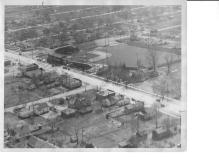
|
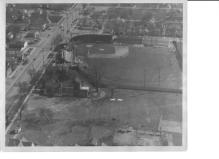
|
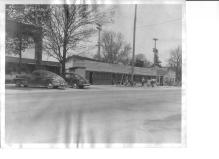
|
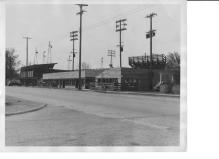
|
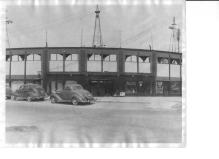
|
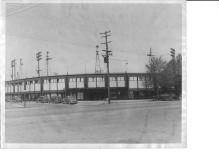
|
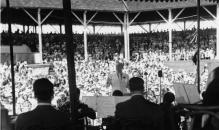
|

1938 |
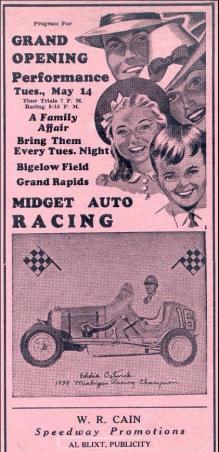
|
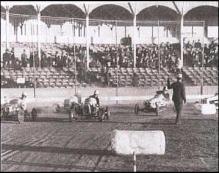
|
Located at the northwest corner of the intersection of what is now 39th Street and Division Avenue, Bigelow field was a source of local entertainment in the Godwin area from 1936, until it burned in 1952. For whatever the reasons, there was no desire to rebuild. Around that time most of the small baseball teams, and the Grand Rapids hockey team, went out of existence. Perhaps it was yet another effect of television. People were able to watch major league sports, and interest in small, home town teams dried up.
Occasionally the source of major entertainment, the New York Yankees played at Bigelow field in 1937. See below for the program. Shown in the photograph in the bottom row, above, Paul Whiteman and his orchestra played at Bigelow field in 1938. In the summer of 1946 Bob Hope played there.
In the aerial photograph at left, top row, above, the street going left from Division Avenue is Himes Street. Just visible a ways further left along Division Avenue is Abbie Street. Aerial photographs were apparently frequently taken of the area around Godwin school, which was next to the airport, but so far few have become available for this site.
The photographs in the top row, above, right, and the left, middle row, show some expansion of the store area, in about 1940. Bob Morris, of Morris Electric, did the electrical wiring for the new buildings, and supplied the photographs. In the middle photograph, middle row, one can see the names of some of the businesses located in the store area.
Left click on any image for a larger version.
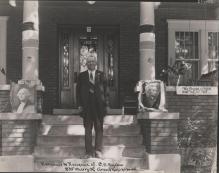
1925 |
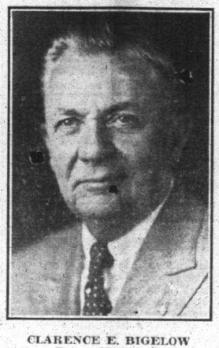
c1936 |
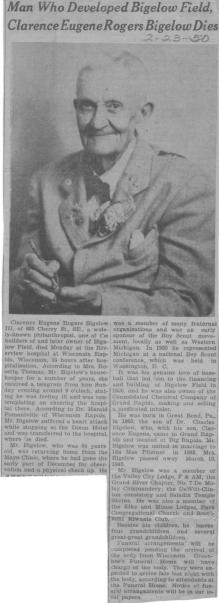
Feb 23, 1950 |

Feb 23, 1950 |

Feb 23, 1950 |
Material provided by Lillian Annis, class of 1941.
Mike Bloore, class of 1955, worked at Bigelow field as a "Ball Boy," and relates the following: "The main reason for this email however, evolves around Bigelow field, and my experience there in 1952-1953 as a "Ball Boy" when the Grand Rapids Chicks Girls Baseball team played there. The roof of the grandstand at Bigelow was not too high, and foul balls frequently went over the roof and out onto Division Avenue. Before each game I went up to the roof through an access ladder on the Northeast corner of the grandstand, and sat on the roof directly behind home plate Talk about the best seat in the house! When a foul ball went over he roof, I would run to the backside of the grandstand, point in the direction of the ball flight, and yell "BALL OVER!!" That would cause a mad scramble amongst the many kids out on the street outside the stadium, hoping to find the ball - The lucky kid who found the ball would take it to the main entrance, where they would receive free admission to the game.
Since I was a young curly-haired kid, I became friends with several of the players, and some of them actually came over to my home for dinner. Most of these young girls were far away from home, and longing for a good home cooked meal. My mother, Clara Bloore (who by the way worked in the Godwin cafeteria), fixed them up with some good ole' fried chicken and biscuits - As a token of their appreciation, they gave me an 'Official Girls Baseball League' baseball autographed by most of the team, including Connie Wisnewski, Corky Olinger, Sadie Satterfield, Ziggy Ziegler, and many others.
My father put a coat of shellac on the ball to preserve it, and while it did save it over the years, the shellac has caused some discoloration of the covering."
One again sees the more family oriented times of the early 1950s and before in the Godwin area. Bigelow field was built by man interested in baseball, and interested in providing access to it in his community. Of course once the stadium burned down, it was not rebuilt, perhaps a reflection of the fact that by then television was broadcasting professional baseball games, and people mostly lost interest in the more amateur, but family oriented, activities at places like Bigelow field. It's more than a coincidence that the Southlawn theater died out in about 1950 too, no doubt in part another casualty of television, and a new found reason to stay home rather than engage the community.
The names on the ball are approximately as below. Not all can be read clearly, so corrections will have to be made. Please send e-mail if you recognize any names in error.
Alphabetical, by last name.
Jaynine Bittman
Dottie Hunter
Margie Jihasstri
Mary L...ka
"Dolly" Niemier
Pepper Paine
Maxine Redman
Dorrie Reid
Beans Ricinger
Sadie Saiterf...,
Lefty Voyer
Renae Youngberg
Ziggy Ziegler
Left click on any image for a larger version.
In year 2006 it is hard to believe that the New York Yankees would be at Bigelow Field playing a teachers college team. The Great Depression was still in full force however, and people sacrificed more to ensure that everyone got a little distraction from their daily woes. In today's world it is simply unimaginable that ball players making millions of dollars a year would take time from their high flying lives to do something similar, no matter what the occasion.
Lee Neugent, class of 1948, relates some other amusing things about Bigelow field over the years:
And then there was the circus.
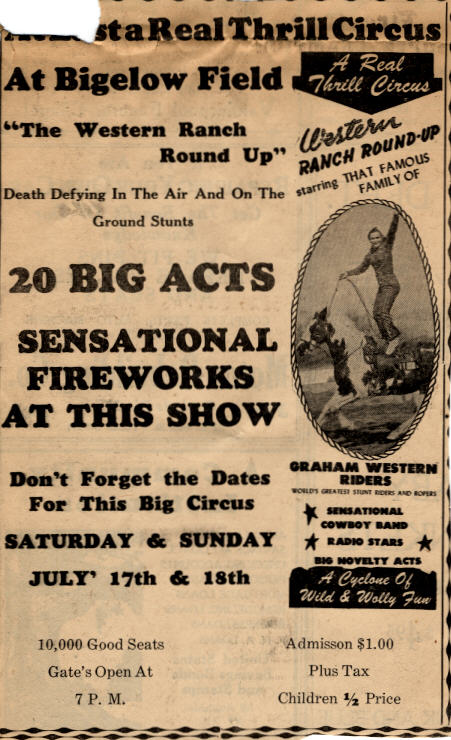
Clearly Bigelow field was a major source of entertainment for the community during the non winter months. Despite this, apparently television and other forces had made an anachronism of the field by the time it burned down in 1952, and there was no effort to rebuild. At about the same time the women's baseball teams, formed during WWII, were disbanding. In a trend that continues in year 2006, a sense of community was being lost, and people stopped mingling with their neighbors to the same degree they had. Today most areas of the US are essentially communities of strangers. Homes contain entertainment centers, and a culture satisfied to surf channels with a remote and munch chips is not very interested in community involvement and bonding.
Left click on the images below for larger versions.
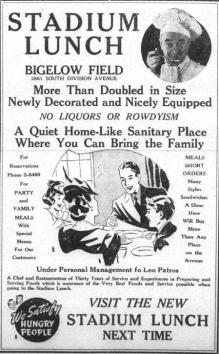
|
The end of Bigelow Field came on July 16, 1952, about four hours
after the finish of a Chicks baseball game. See below for details.
Left click on either image for a much larger version.
|
|
|
|
|


Left click on the images below for larger versions.

|
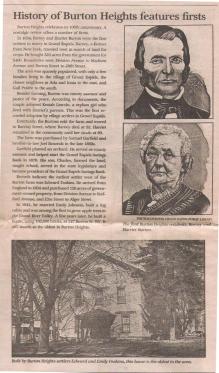
|
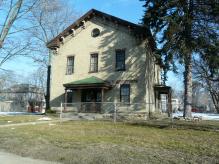
Edward Feakins house - March 8, 2013 |
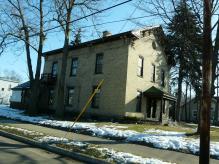
March 8, 2013 |
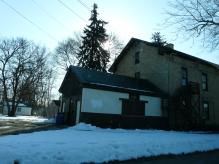
March 8, 2013 |
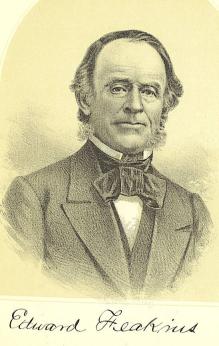
Edward Feakins - 1881 - Baxter. |

|
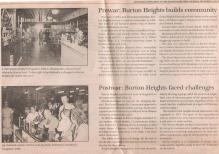
|

|
The material above was provide by Jalene Doxtator, class of 1947.
Left click on the image below for a larger version.
Left click on the images below for larger versions.

|
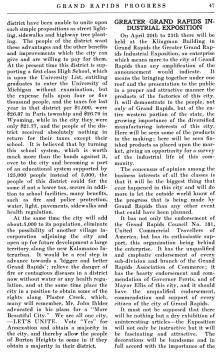
|
Left click on the images below for larger versions.

|
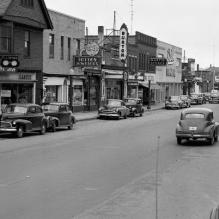
|
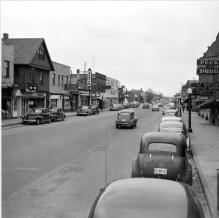
|
Left click on the images below for larger versions.

Burton Heights Methodist Church 1931 - Burton & Horton |
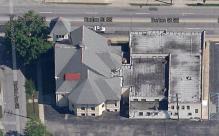
2013 |

2013 |


